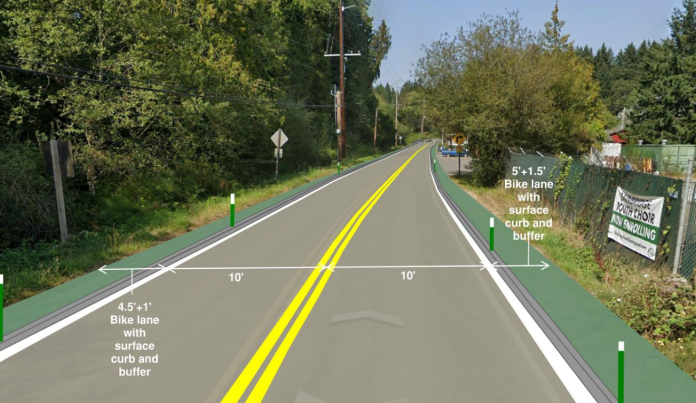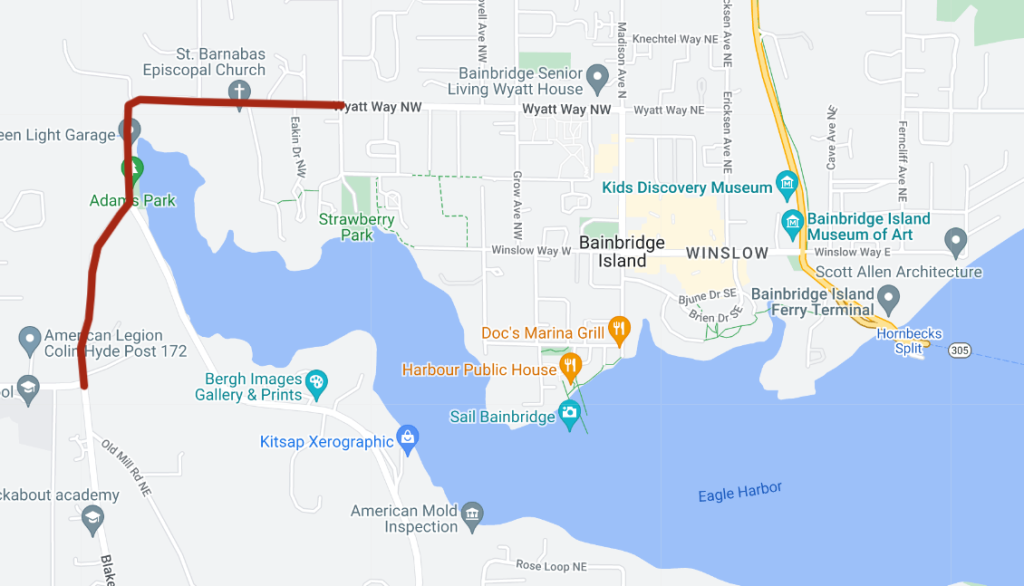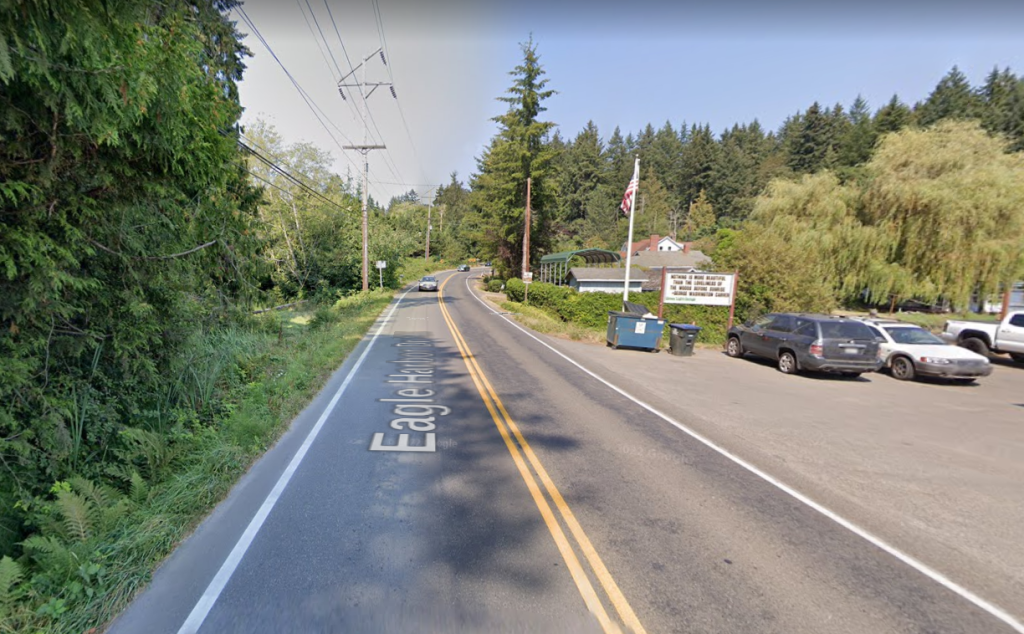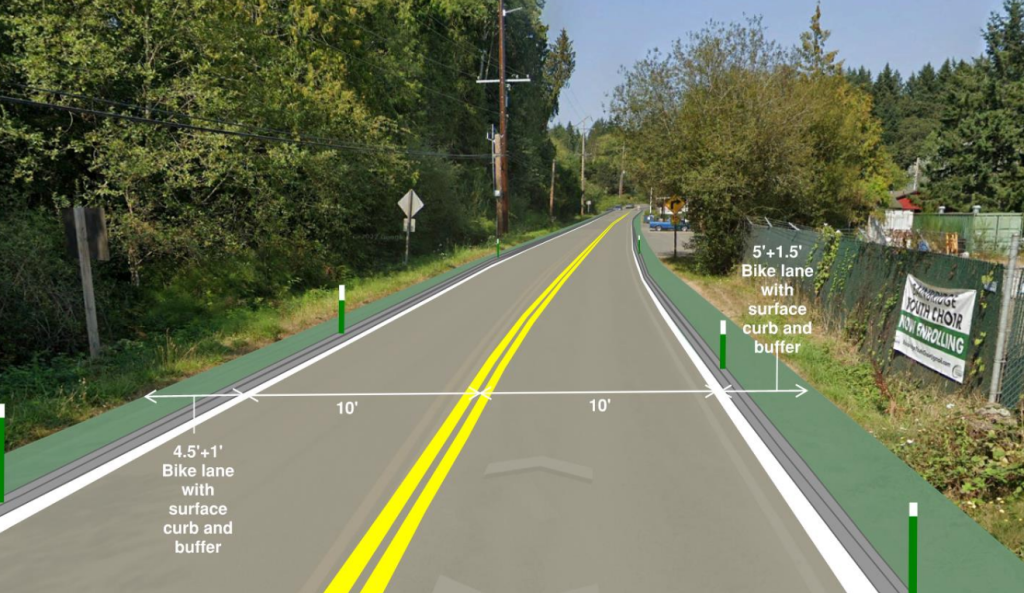
Barely a year after approving an ambitious plan to systematically improve access for people who walk, bike, and roll, the Bainbridge Island City Council voted to hinder the entire city’s bike network and reduce momentum for future improvements. The council decision earlier this month veered from City staff recommendations, which were aimed at pedestrian improvements and all ages facilities in addition to upgrades for confident cyclists. A months-long debate around selecting a preferred design for a key bike route has highlighted a deep divide among city councilmembers around what types of users the city is trying to attract, and how to make different types of road users feel safe biking on Bainbridge Island.

Wyatt Way NW, which transitions to Eagle Harbor Drive, is the second highest-volume street on Bainbridge Island outside of State Route 305. It’s the primary way that the south end of the island is accessed from Winslow, where the Washington State Ferry terminal and most of the commercial services in Bainbridge are located. Someone wanting to bike from downtown Winslow to Lynwood, the main commercial center on the south end of the Island, will want to use Wyatt Way, but currently the street is two lanes of fast-moving traffic with a narrow shoulder barely wide enough for a bike, much less someone walking. There are no sidewalks.

For most of this year, Bainbridge city staff have been working with consultants to design several alternatives for safer walking and biking facilities along the street, with facilities for people on bikes mostly dominating the conversation. In the end, two designs were put forward by city staff: a two-way bike lane along the north and west side of the road, and one way protected bike lanes on either side of the street. Both types of lanes were set to be separated from the roadway traffic by a physical curb.
The “bidirectional path” would have separated users from many of the driveways along the street, including at an auto repair shop and a city park. But it would also have meant some more awkward movements to exit and enter the facility. And it would have functioned as some kind of walkway for people trying to get through the area on foot.

At major intersections, including Finch Road NE, the facility would jog back to a crosswalk separated from where drivers are trying to turn onto Wyatt Way, which will add time compared to taking the lane. The purpose of the bidirectional bike lane is to provide space for people who might not be comfortable close to the fast moving traffic normally on Wyatt Way.

The one-way bike lanes function more similar to what people who already ride bikes on Bainbridge Island are used to, but with not much room for someone walking along the road to feel comfortable next to traffic, especially not if someone comes along trying to use the bike lane. A hard curb would separate the lane from traffic, but there have been calls to eliminate that curb entirely so that people taking the traffic lane on their bikes can transfer back to the bike lane as desired. However, that would eliminate the entire purpose of a protected bike lane: protection from car traffic.

After postponing a final decision earlier this year, this month the council voted to proceed with full design on the one-way bike lanes, by a closely divided vote of 4 to 3. In the end, it came down more to the gut feelings councilmembers had about which option would be safer, and less about any data that had been presented over the preceding months.

Marya Dominik and Rakesh Bharania live directly on the route of the proposed bike path off Eagle Harbor Drive.
“My personal feeling is that the interest of commuter cyclists, who basically just want to go fast and have maximum freedom of the road, was elevated above every other constituent interest, both those of us who live on the route as well as those who might use the future route,” Bharania told The Urbanist.
“It’s not just a bike lane,” Dominik said. “It’s all access, for all users.”
“We’re going to have a gap in our all ages, all abilities network in a really core location,” Susan Loftus, founder of Bainbridge GreenWays, said. “There just wasn’t a willingness to understand how a network has to function in order for children, or most people, to be able to use it,” she said of the council vote. “This was the capstone of about five years of work: collaborating with current cyclists, and our group really reaches out to a lot of parents and students. This is a facility that’s within two miles of four schools. Every single student has to pass through this route to get to school from the south part of the island. There’s no other alternative.”
Ahead of the vote, however, councilmembers defended their own conceptions of what would be safest for potential users along the corridor. Councilmember Clarence Moriwaki, who voted for the one-way bike lane option, even went so far as to directly discount the recommendation of staff, comparing the potential design of a bike lane to both the Titanic disaster and the recent loss of the submersible Titan that had been attempting to explore the Titanic’s wreckage.
“You know, engineers signed off on the Titanic,” Moriwaki said. “And look at those guys, those billionaires that went down in that death capsule with a PlayStation controller for the joystick that was signed off by engineers as safe.”
“The differing perceptions of safety has been a real painful divider in our community,” Councilmember Leslie Schnieder, the strongest champion of the sustainable transportation plan, said ahead of her vote for the rejected bidirectional bike lane.
Schnieder was also the only vote on the council against directing staff to look at implementing a barrier between the travel lane and the bike lane that can be easily mounted by cyclists — and by drivers. Ultimately, Schnieder said, the council should rally around any decision made by council so the city can move forward with constructing safer facilities on Wyatt Way.
Another hope of implementing a two-way path here was that the concept would prove successful and could be implemented elsewhere in Bainbridge — not in dense areas like downtown Winslow but between other commercial centers along long stretches of roadway. A two-way bike lane was envisioned on New Brooklyn Road as well, a key east-west connector across Bainbridge.

The vote calls into question just how ready the Bainbridge council is ready to follow through on its commitment to connect the island with high quality bike facilities that are designed to attract people who might not be ready to jump on a bike and use the current roadways. Councilmember Jon Quitslund, who also voted for the one-way bike lanes, directly noted that the council was contradicting its own prior direction, praising the 2022 Sustainable Transportation Plan in theory.
“But implementation, which is where we are now is a different exercise,” Quitslund said. “It involves more people, it involves different considerations. So we should be looking fresh at what we need to take into account, and how we need to regard the interest of the larger community… I’m still a supporter of the Sustainable Transportation Plan. But there are aspects of it that are just very, very aspirational.”
With a majority of the city council not ready to follow through on those aspirations, Bainbridge Island could be set to squander future investments as they continue to draw a distinction between lofty plans and on-the-ground reality.
Ryan Packer has been writing for The Urbanist since 2015, and currently reports full-time as Contributing Editor. Their beats are transportation, land use, public space, traffic safety, and obscure community meetings. Packer has also reported for other regional outlets including Capitol Hill Seattle, BikePortland, Seattle Met, and PubliCola. They live in the Capitol Hill neighborhood of Seattle.


